AGFA ePhoto1280 DIGITAL CAMERA
by John Henshall
My mailbag shows that there is undoubtedly a lively professional
interest in the lower-cost digital products such as cameras, scanners and
printers. This may well be because higher-end products cost many thousands
of pounds and are considered a risk or unjustifiable expense by many photographers
- photographers who would otherwise be keen to dip their toes in the digital
water. But lower cost digital products can now produce results which are
very close to the much more expensive products which have been around for
some years. The gap is narrowing.
Earlier this year, Fuji effectively bridged the gap between
low- and high-end digital cameras, particularly its own DS-7 and DS-505/515,
when it introduced the DS-300 at around £2,000. It uses the same chip
as the high-end cameras but in a magnesium alloy body, reminiscent of Fuji's
medium format film cameras. At the same time, Kodak's DC120 bridged the
gap between their DC50 and DCS420. (See Chip Shop
May 1997).
Last month
I used the sub-£300 Agfa ePhoto307 for editorial shots but, although
the results are astonishingly good at the small size used, this camera is
too basic for regular professional use.
When considering the possible suitability of a digital
camera for professional use, I judge whether it could be used to capture
images good enough for either full page, half page or quarter page in a
high-quality magazine. If you and I can't tell the difference between film
and digital origination on these pages, then the quality is sufficient for
the purpose. The Fuji DS-300 almost passes this test at half-page and certainly
would pass at quarter page (see Chip Shop May 1997).
But the DS-300 would be no good for close-up work because it is not an SLR.
In fact, most of my product shots for Chip Shop (including this month's)
are taken on my five year old Kodak DCS200, still going strong.
This month we are first to test a new camera, the Agfa
ePhoto1280, 'biked out from darkest Brentford to sunny Oxfordshire soon
after it arrived in the country.
 The ePhoto1280 is the sequel
to the ePhoto307, also a project of Agfa's American wing in Wilmington,
Massachusetts. It uses a 810,000 pixel chip - almost three times the pixel
count of the '307. It works with both Windows PCs and Macintosh - and also
has a NTSC or PAL video output, enabling shots to be viewed on a television
monitor. My wife gave the unsolicited verdict on this facility when she
saw the images displayed on a 28-inch Bang & Olufsen television in the
studio: "Are those pictures off that camera? Wow!"
The ePhoto1280 is the sequel
to the ePhoto307, also a project of Agfa's American wing in Wilmington,
Massachusetts. It uses a 810,000 pixel chip - almost three times the pixel
count of the '307. It works with both Windows PCs and Macintosh - and also
has a NTSC or PAL video output, enabling shots to be viewed on a television
monitor. My wife gave the unsolicited verdict on this facility when she
saw the images displayed on a 28-inch Bang & Olufsen television in the
studio: "Are those pictures off that camera? Wow!"
The camera is unusual in design. It features a 3-to-1 optical
zoom, said to be equivalent to 38-114mm on a 35mm film camera and to have
a maximum aperture of f2.8 (at wideangle) to f3.5 (at telephoto). Auto focus
is from 10cm at wideangle, or 80cm at telephoto, to infinity. A flash sticks
out from the side of the lens mount. This part of the camera, on the photographer's
left of the camera, can be rotated independently through 280 degrees - very
useful for taking high and low shots and getting into awkward places.
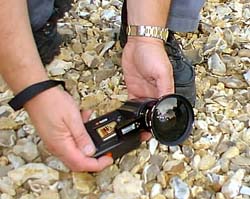 In the low-angle picture,
I am using a x0.5 supplementary lens, bought for my old camcorder, which
halved the focal length of the lens and gave a very interesting full-frame
fisheye effect at the widest zoom setting. This fitted perfectly, screwing
into the lens' 46mm filter thread. When the two halves of the camera are
rotated the flash, sticking out from the side of the lens mount, looks somewhat
prone to damage.
In the low-angle picture,
I am using a x0.5 supplementary lens, bought for my old camcorder, which
halved the focal length of the lens and gave a very interesting full-frame
fisheye effect at the widest zoom setting. This fitted perfectly, screwing
into the lens' 46mm filter thread. When the two halves of the camera are
rotated the flash, sticking out from the side of the lens mount, looks somewhat
prone to damage.
The right section of the camera has a high definition 2-inch
LCD panel. There is also a bright red exposure button. A rotating wheel
on the right edge selects capture or playback modes. An 'EasyPilot' control
- a clever combination of small selector wheel and push button - is used
to select all the camera's functions: resolution, flash, low-light viewfinder,
self-timer, focus, exposure, white balance, external flash, delete pictures
and other modes. There is no optical viewfinder and unfortunately no hood
or magnifier for the LCD panel, which would make viewing much easier in
high ambient light. This could be a profitable area for far-eastern accessory
manufacturers.
The camera is powered by four AA-size nickel metal hydride
batteries. This pre-production camera came with two sets of batteries and
a fast charger. Images are stored inside the camera on a removable 'SmartMedia'
Toshiba SSFDC (Solid State Floppy Disk Card) like the ones used in the Fuji
DS-7. Note 'like' but not 'the same as'. Agfa uses 3.3-volt while Fuji uses
5-volt cards. The two are not interchangeable. The camera comes with one
4MB card, neatly hidden away in a compartment revealed when the two parts
of the camera are rotated. Further cards will be available, including an
8MB version, de-restricting the number of images which can be captured.
 Before taking a picture, decide
upon the resolution required and set it using the EasyPilot control. The
CCD has 1024 x 768 pixels and five resolution settings are offered. First
is 1280 mode (1280 x 960 pixels). Using this mode, images are first captured
as 1024 x 768 pixel images but marked as requiring interpolation up to 1280
x 960 by 'PhotoGenie' in the PhotoWise acquisition software. PhotoGenie
works on the images to minimise JPEG compression artifacts visible in the
image. In the meantime, they are stored on the SSFDC with a low compression
ratio, to minimise loss. Six of these images can be stored on the SSFDC.
Next come 780Hi(gh) and 780S(tandard) modes. Both store the images at 1024
x 768 pixels but each using increased compression over the previous. The
card will hold 12 images at 780H or 24 at 780S. Finally 370H and 370S modes,
which store 30 or 60 on the card as 640 x 480 pixel images. Images of differing
resolutions may be combined on the same card.
Before taking a picture, decide
upon the resolution required and set it using the EasyPilot control. The
CCD has 1024 x 768 pixels and five resolution settings are offered. First
is 1280 mode (1280 x 960 pixels). Using this mode, images are first captured
as 1024 x 768 pixel images but marked as requiring interpolation up to 1280
x 960 by 'PhotoGenie' in the PhotoWise acquisition software. PhotoGenie
works on the images to minimise JPEG compression artifacts visible in the
image. In the meantime, they are stored on the SSFDC with a low compression
ratio, to minimise loss. Six of these images can be stored on the SSFDC.
Next come 780Hi(gh) and 780S(tandard) modes. Both store the images at 1024
x 768 pixels but each using increased compression over the previous. The
card will hold 12 images at 780H or 24 at 780S. Finally 370H and 370S modes,
which store 30 or 60 on the card as 640 x 480 pixel images. Images of differing
resolutions may be combined on the same card.
 To evaluate the various resolution modes I
photographed a video camera resolution chart. All the ePhoto1280's resolution
modes have an aspect ratio of 4 to 3 (1.33 to 1) - the same as television
- so the chart should fill the screen perfectly. I framed the chart accurately
using the LCD panel and a tripod but the camera saw slightly more, shooting
off the edges of the chart. The blow-ups of sections of the chart, near
the centre, at each of the five resolutions. Note the increasing JPEG artifacts
as we go down through the modes from 1280 to 307S, Note also that the amount
of pseudo-sharpening also increases. These are brutal enlargements for images
of this kind - equivalent to sections of a 20 x 16-inch print - but they
do show the trade-offs necessary to cram more images onto the SSFDC media.
To evaluate the various resolution modes I
photographed a video camera resolution chart. All the ePhoto1280's resolution
modes have an aspect ratio of 4 to 3 (1.33 to 1) - the same as television
- so the chart should fill the screen perfectly. I framed the chart accurately
using the LCD panel and a tripod but the camera saw slightly more, shooting
off the edges of the chart. The blow-ups of sections of the chart, near
the centre, at each of the five resolutions. Note the increasing JPEG artifacts
as we go down through the modes from 1280 to 307S, Note also that the amount
of pseudo-sharpening also increases. These are brutal enlargements for images
of this kind - equivalent to sections of a 20 x 16-inch print - but they
do show the trade-offs necessary to cram more images onto the SSFDC media.

Above: blow-up of a section of the chart at 1280 mode.

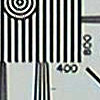
Above left: at 780H(igh) mode. Above right: at 780(S)tandard
mode.


Above left: at 307H(igh) mode. Above right: at 307(S)tandard
mode.

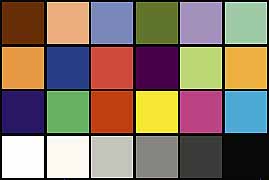
I also took a shot of a Macbeth colour chart, reproduced
here (above left) alongside a digitally generated version (above right)
which has gone through the same reproduction process.
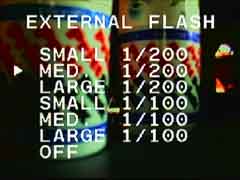
 The flash has the usual Auto, Fill-in, Red-eye reduction
and off settings. Additionally, tucked away in the Advanced Mode settings,
are six further flash settings. These allow the shutter and lens aperture
to be fixed at any combination of 1/100 or 1/200 second and f2.8-3.5 (depending
on lens angle), or f5.6-6.4, or f8-9.1. The on-camera flash may then be
used to trigger studio flash units. This is a well thought out facility,
of particular interest to the professional.
The flash has the usual Auto, Fill-in, Red-eye reduction
and off settings. Additionally, tucked away in the Advanced Mode settings,
are six further flash settings. These allow the shutter and lens aperture
to be fixed at any combination of 1/100 or 1/200 second and f2.8-3.5 (depending
on lens angle), or f5.6-6.4, or f8-9.1. The on-camera flash may then be
used to trigger studio flash units. This is a well thought out facility,
of particular interest to the professional.
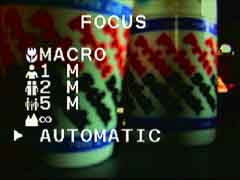 Besides autofocus, the lens may be set to fixed focus
at one, two or five metres, or at macro or infinity. Shutter speed is automatically
set from 1/4 and 1/500 second, or manually from 1/8 to 1/500.
Besides autofocus, the lens may be set to fixed focus
at one, two or five metres, or at macro or infinity. Shutter speed is automatically
set from 1/4 and 1/500 second, or manually from 1/8 to 1/500.
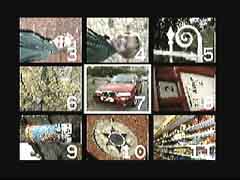
 In playback mode, a series of nine consecutive images
may be displayed, from which any one may be selected and brought up to full
screen. Individual images - or the whole card - may be deleted. Date and
time of exposure, number of images taken/remaining and battery state may
all be displayed on the LCD.
In playback mode, a series of nine consecutive images
may be displayed, from which any one may be selected and brought up to full
screen. Individual images - or the whole card - may be deleted. Date and
time of exposure, number of images taken/remaining and battery state may
all be displayed on the LCD.
The camera is just over six inches wide by two high by
nearly four from front to back - approximately 15 x 5 x 10cm. It weighs
about one pound - 450g.
Agfa work with Sierra
Imaging Inc to produce PhotoWise, some of the best acquisition and processing
software around.

The new version 1.5 supplied with ePhoto1280 incorporates
PhotoGenie to clean-up the images so that they can be interpolated up in
resolution without undesirable artifacts.
Now for the most important aspect of any digital camera:
the images it produces. All the images were taken using the camera hand-held.
First an important note for the web version
of this article: all these images have been reduced to one-ninth of their
original size. So 1280 x 960 images have been reduced to 427 x 320, and
1024 x 768 images have been reduced to 256 x 341 pixels. In addition they
have been JPEGed again (they were JPEGed in the camera, remember) at the
"Quality 3 - Medium" setting in Adobe Photoshop 4 - a compromise
between quality and size for the web. That's a lot of size and quality
reduction for images designed to show what the camera is capable of. Please
bear this in mind when you look at these pictures - and wait for them to
download!
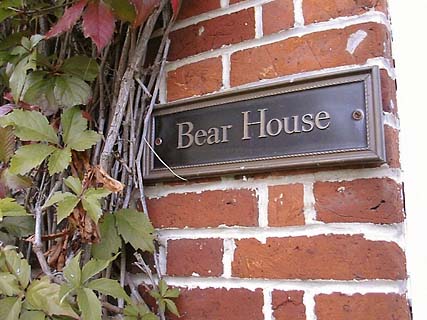
The Bear House nameplate was shot in the shade, mainly
lit by a cloudless sky, at the top (1280) resolution mode. Automatic white
balance has handled this lighting well. The white paint on the right of
the shot was only partly visible in the viewfinder. Auto exposure places
this at just the right level.
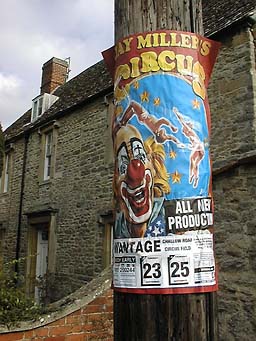
The other images were all taken at the 780H setting. The
circus poster was chosen as a difficult one for the auto exposure: the poster
is caught in the soft evening sun, the sky is bright and the house is in
the shade.
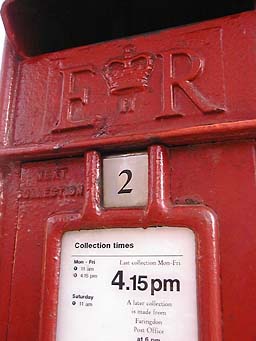
The pillar box goes from black to white. It is also very
saturated being painted in 'Post Office Red' paint. Compared with the colours
of the ePhoto307, the ePhoto1280 has much better (lower) colour saturation,
which gives much more subtle tonal gradation in the red. And it handles
the dynamic range superbly.
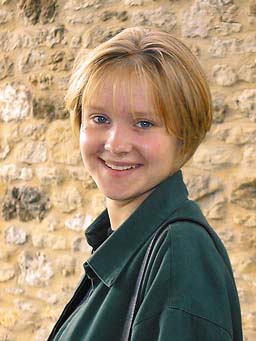
This exterior portrait was taken in the shade of a tree,
with the late sun kicking the cheek, testing the camera's fill-in flash
capabilities.

This car is just the kind of image which this camera might
be used for. Note the handling of chrome, car and surrounding colour.
The camera captures images at ten bits per RGB channel
- in other words it samples the image into 1024 discrete levels. Only 256
levels are needed in the final image, so this gives quite a bit of latitude
and accounts for the very appealing dynamic range.
So is the ePhoto1280 a professional camera? Or amateur?
Or business? It is suitable for aspects of all three. Externally, it isn't
built like a professional camera but the images it produces are certainly
good enough for professional use. I would use it without hesitation for
editorial shots, both in the studio and at trade shows and conferences.
The camera would also be perfect for capturing images for the Internet -
digital catalogues and so on. Picture quality is superb. My main criticisms
are the time taken to store images - nearly fifteen seconds before you can
take the next picture - and the time taken to download the images to the
computer by serial cable link. Even at the fastest speed of 115,200 BPS
it took 17minutes 42 seconds to download a card-full of images. A separate
card reader (or PCMCIA slot adapter) would allow the SSFDC card to be taken
out of the camera and read immediately into the computer. It would be in
Agfa's best interests to supply one for users of laptops. How I hate serial
interfaces! Roll on FireWire.
One of the main uses of a camera such as this will be business
- high quality images for reports and documents. Some of this could take
work away from professional photographers: it's too easy to get good pictures.
Even if you don't get a good shot first time, you can keep on experimenting
at no cost. As for amateur use, surely a camera such as this would be too
expensive?
So how much does it cost? £2,000? £1,500? £1,000?
Keep going down. It costs £552.34 or £649 including VAT (UK
sales tax). That's only 0.07 of a penny per useable pixel. This must be
the best digital camera bargain yet. What so often happens with digital
cameras is that they come onto the market at a high price which immediately
puts potential customers off, only to be cut drastically a few weeks or
months later. Agfa haven't made that mistake this time.
The Agfa ePhoto1280 is a superb camera at an unbelievably
low price for all its facilities and state-of-the-art technology. If you've
been hesitant about dipping your toes into the digital water, this could
be exactly the push you've been waiting for.
For further information see the ePhoto
website or telephone Nick Mongston at Agfa UK on 0181 231 4342 (please
tell him you saw it mentioned here.)
This article first appeared as "John
Henshall's Chip Shop" in "The Photographer" magazine, October
1997.
IMPORTANT NOTICE
This document is Copyright © 1997 John Henshall. All rights reserved.
This material may only be downloaded for personal non-commercial use. Please
safeguard the future of online publishing by respecting this copyright and
the rights of all other authors of material on the Internet.


 The ePhoto1280 is the sequel
to the ePhoto307, also a project of Agfa's American wing in Wilmington,
Massachusetts. It uses a 810,000 pixel chip - almost three times the pixel
count of the '307. It works with both Windows PCs and Macintosh - and also
has a NTSC or PAL video output, enabling shots to be viewed on a television
monitor. My wife gave the unsolicited verdict on this facility when she
saw the images displayed on a 28-inch Bang & Olufsen television in the
studio: "Are those pictures off that camera? Wow!"
The ePhoto1280 is the sequel
to the ePhoto307, also a project of Agfa's American wing in Wilmington,
Massachusetts. It uses a 810,000 pixel chip - almost three times the pixel
count of the '307. It works with both Windows PCs and Macintosh - and also
has a NTSC or PAL video output, enabling shots to be viewed on a television
monitor. My wife gave the unsolicited verdict on this facility when she
saw the images displayed on a 28-inch Bang & Olufsen television in the
studio: "Are those pictures off that camera? Wow!" In the low-angle picture,
I am using a x0.5 supplementary lens, bought for my old camcorder, which
halved the focal length of the lens and gave a very interesting full-frame
fisheye effect at the widest zoom setting. This fitted perfectly, screwing
into the lens' 46mm filter thread. When the two halves of the camera are
rotated the flash, sticking out from the side of the lens mount, looks somewhat
prone to damage.
In the low-angle picture,
I am using a x0.5 supplementary lens, bought for my old camcorder, which
halved the focal length of the lens and gave a very interesting full-frame
fisheye effect at the widest zoom setting. This fitted perfectly, screwing
into the lens' 46mm filter thread. When the two halves of the camera are
rotated the flash, sticking out from the side of the lens mount, looks somewhat
prone to damage. Before taking a picture, decide
upon the resolution required and set it using the EasyPilot control. The
CCD has 1024 x 768 pixels and five resolution settings are offered. First
is 1280 mode (1280 x 960 pixels). Using this mode, images are first captured
as 1024 x 768 pixel images but marked as requiring interpolation up to 1280
x 960 by 'PhotoGenie' in the PhotoWise acquisition software. PhotoGenie
works on the images to minimise JPEG compression artifacts visible in the
image. In the meantime, they are stored on the SSFDC with a low compression
ratio, to minimise loss. Six of these images can be stored on the SSFDC.
Next come 780Hi(gh) and 780S(tandard) modes. Both store the images at 1024
x 768 pixels but each using increased compression over the previous. The
card will hold 12 images at 780H or 24 at 780S. Finally 370H and 370S modes,
which store 30 or 60 on the card as 640 x 480 pixel images. Images of differing
resolutions may be combined on the same card.
Before taking a picture, decide
upon the resolution required and set it using the EasyPilot control. The
CCD has 1024 x 768 pixels and five resolution settings are offered. First
is 1280 mode (1280 x 960 pixels). Using this mode, images are first captured
as 1024 x 768 pixel images but marked as requiring interpolation up to 1280
x 960 by 'PhotoGenie' in the PhotoWise acquisition software. PhotoGenie
works on the images to minimise JPEG compression artifacts visible in the
image. In the meantime, they are stored on the SSFDC with a low compression
ratio, to minimise loss. Six of these images can be stored on the SSFDC.
Next come 780Hi(gh) and 780S(tandard) modes. Both store the images at 1024
x 768 pixels but each using increased compression over the previous. The
card will hold 12 images at 780H or 24 at 780S. Finally 370H and 370S modes,
which store 30 or 60 on the card as 640 x 480 pixel images. Images of differing
resolutions may be combined on the same card. To evaluate the various resolution modes I
photographed a video camera resolution chart. All the ePhoto1280's resolution
modes have an aspect ratio of 4 to 3 (1.33 to 1) - the same as television
- so the chart should fill the screen perfectly. I framed the chart accurately
using the LCD panel and a tripod but the camera saw slightly more, shooting
off the edges of the chart. The blow-ups of sections of the chart, near
the centre, at each of the five resolutions. Note the increasing JPEG artifacts
as we go down through the modes from 1280 to 307S, Note also that the amount
of pseudo-sharpening also increases. These are brutal enlargements for images
of this kind - equivalent to sections of a 20 x 16-inch print - but they
do show the trade-offs necessary to cram more images onto the SSFDC media.
To evaluate the various resolution modes I
photographed a video camera resolution chart. All the ePhoto1280's resolution
modes have an aspect ratio of 4 to 3 (1.33 to 1) - the same as television
- so the chart should fill the screen perfectly. I framed the chart accurately
using the LCD panel and a tripod but the camera saw slightly more, shooting
off the edges of the chart. The blow-ups of sections of the chart, near
the centre, at each of the five resolutions. Note the increasing JPEG artifacts
as we go down through the modes from 1280 to 307S, Note also that the amount
of pseudo-sharpening also increases. These are brutal enlargements for images
of this kind - equivalent to sections of a 20 x 16-inch print - but they
do show the trade-offs necessary to cram more images onto the SSFDC media.







 The flash has the usual Auto, Fill-in, Red-eye reduction
and off settings. Additionally, tucked away in the Advanced Mode settings,
are six further flash settings. These allow the shutter and lens aperture
to be fixed at any combination of 1/100 or 1/200 second and f2.8-3.5 (depending
on lens angle), or f5.6-6.4, or f8-9.1. The on-camera flash may then be
used to trigger studio flash units. This is a well thought out facility,
of particular interest to the professional.
The flash has the usual Auto, Fill-in, Red-eye reduction
and off settings. Additionally, tucked away in the Advanced Mode settings,
are six further flash settings. These allow the shutter and lens aperture
to be fixed at any combination of 1/100 or 1/200 second and f2.8-3.5 (depending
on lens angle), or f5.6-6.4, or f8-9.1. The on-camera flash may then be
used to trigger studio flash units. This is a well thought out facility,
of particular interest to the professional. Besides autofocus, the lens may be set to fixed focus
at one, two or five metres, or at macro or infinity. Shutter speed is automatically
set from 1/4 and 1/500 second, or manually from 1/8 to 1/500.
Besides autofocus, the lens may be set to fixed focus
at one, two or five metres, or at macro or infinity. Shutter speed is automatically
set from 1/4 and 1/500 second, or manually from 1/8 to 1/500.
 In playback mode, a series of nine consecutive images
may be displayed, from which any one may be selected and brought up to full
screen. Individual images - or the whole card - may be deleted. Date and
time of exposure, number of images taken/remaining and battery state may
all be displayed on the LCD.
In playback mode, a series of nine consecutive images
may be displayed, from which any one may be selected and brought up to full
screen. Individual images - or the whole card - may be deleted. Date and
time of exposure, number of images taken/remaining and battery state may
all be displayed on the LCD.




